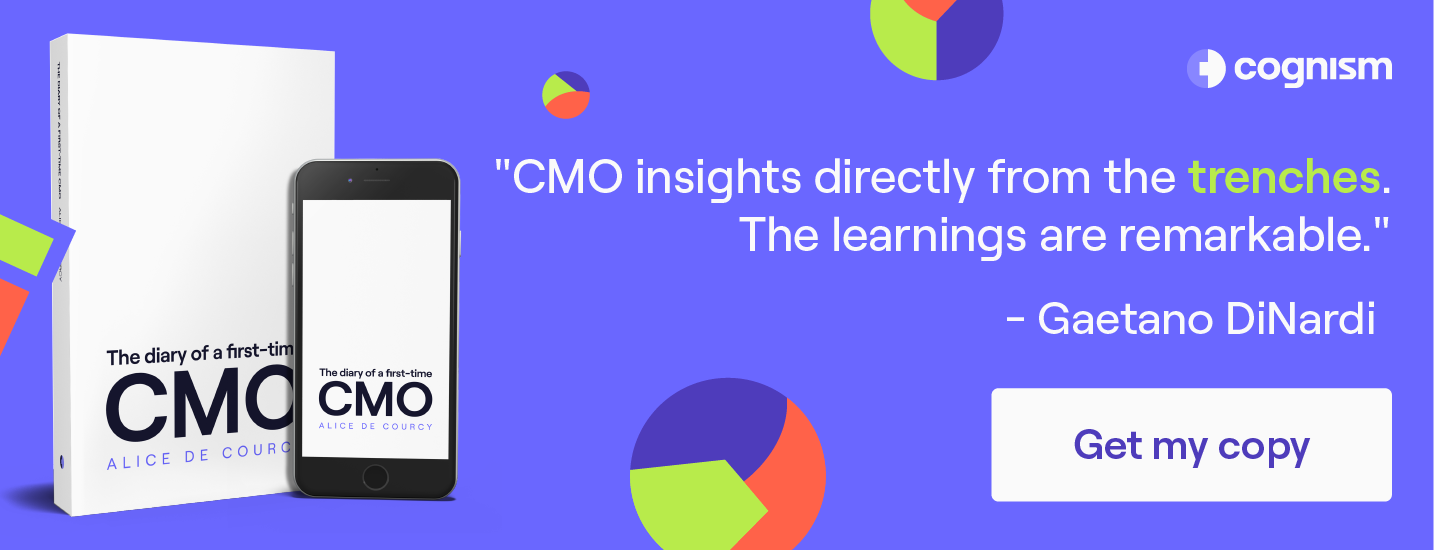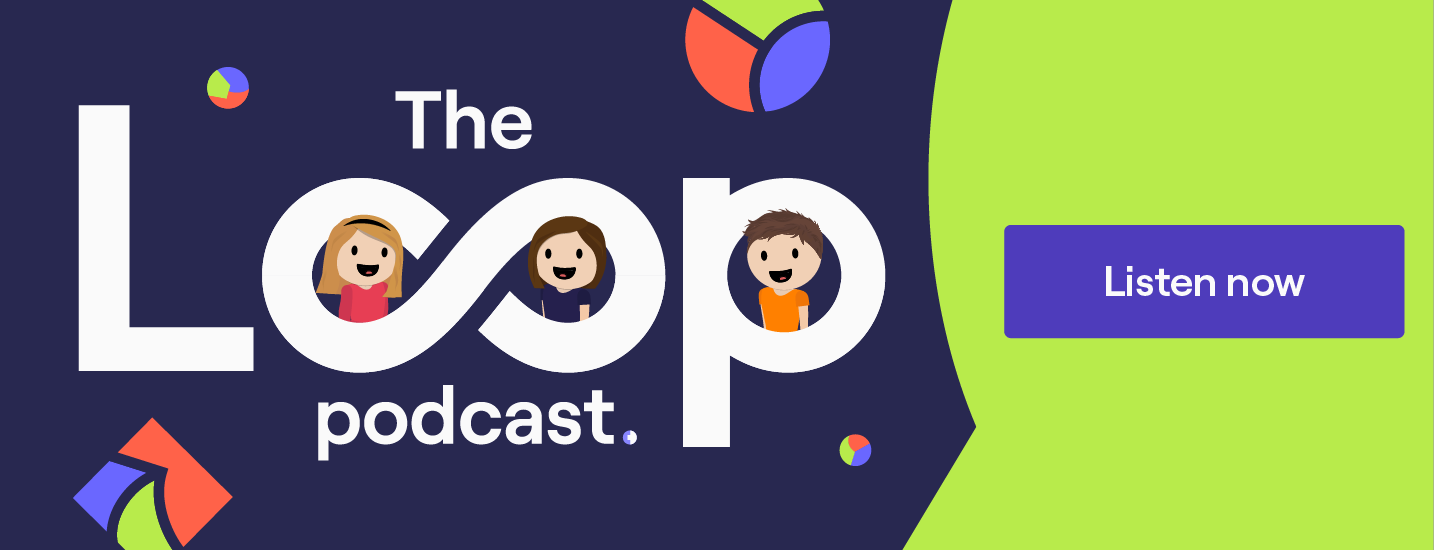The Ultimate Guide to eBook Marketing: Strategies for 2025
You might be thinking… Cognism, talking about doing eBooks again? I thought they hated eBooks…
And yes, we have spoken out a fair amount on how we believe eBooks to be a little outdated.
But the truth is, eBooks don’t have to feel outdated, and you can still get some pretty impressive results from them - if you update the way they’re done.
Because if we break it down, there’s nothing wrong with providing a value-led, long-form content asset packed with insights and useful information aimed at your ICP.
The problem comes when you’re doing eBooks for eBook’s sake. Losing sight of why you’re doing them. Only repeating what we have always done. Not thinking about what works best for the prospects you’re trying to serve in the first place.
Because let’s be real, gated eBooks don’t tend to get the results that they used to…
- Prospects are used to the process; they know what’s coming and are wary of being caught in a low-value content trap followed by premature pushy calls from sales. They’re much more sceptical about giving away their contact details.
- Downloading an eBook ≠ intent to buy. Passing these leads over to sales isn’t likely to spark a productive sales conversation. In fact, the sales rep might end up hearing responses like ‘what eBook…?’
- Prospects are moving more towards finding their information in other formats, e.g. in Slack communities or with video or podcasts.
But what if we were to revolutionise the way we do eBooks?
Giving our eBook philosophy a rehaul!
Well, we’re here to do just that. Just keep reading!
Chapter 1: Modernising the eBook
We believe that if we are to continue using this kind of content - there needs to be a shift in the way we view and deliver eBooks.
Pumping out completely gated eBooks every other month isn’t likely to thrill and excite your potential future customers.
And likely isn’t maximising the impact you could have with eBook activity.
Instead, here’s how we’d propose eBooks should be treated moving forwards.
Wait a second: If you like this, you’ll like the diary of a CMO. Our CMO Alice de Courcy’s lived experience from scaling a marketing team. 👇
eBook goals
Understandably, for many, this will remain a lead-gathering activity. The MQL model is still alive and well for many - especially in larger organisations where they’ve built their structures around this process.
So, for you guys - we get that this next couple of paragraphs might feel like a pipe dream for the moment.
But what if we were to start looking at the goal of an eBook a little differently?

Tom Bangay, Senior Director of Content and Community at Juro, said:
“In the early days, I feel we used eBooks because we didn’t have a huge amount of choice. Who were we going to sell our product to? Why not try the people who downloaded our content.”
“And to be honest, anything we did in those days, to a certain extent, was going to work. We went from having no brand recognition to some - so it was a win.”
“But this approach doesn’t scale well.”
What Tom is getting at here is that we know that buyer behaviour has changed. We can’t push buyers down a neat funnel and expect them to buy at the end. Neither marketers nor salespeople can get buyers to buy before they have a need or are ready to come to you.
So why do we follow an outdated process of collecting leads to hammer with sales calls to buy… when we could take those leads (which are really just contacts!) and get them into a value loop instead?
Value loops are anywhere that your ICP can get regular value from you by following, subscribing or downloading your content, for example - podcasts, newsletters, YouTube channels etc.
In other words, if you could gather the contact details (or not!) of the people who engage with your content and instead redirect them into places where they can have further positive experiences with your brand, getting value from your content and expertise…
When they decide they’re ready and in-market for a product like yours, you’re far more likely to be on the shortlist.
Tom added:
“Our approach changed. We don’t need to convert these people right away. We have them in a group and I email them every week. The focus now is to give them the things that they want. Let’s make them happy and increase brand sentiment.”
“Now, if they ever need the thing that we sell, the chances of us being on the list of vendors they look at is super high.”
“Use it to nurture people and make yourself front of mind when they’re ready to buy.”
Alternatively, for those who are and will continue to collect leads because that’s what the business requires, what if the focus was to turn from the volume of leads to the quality of the leads?
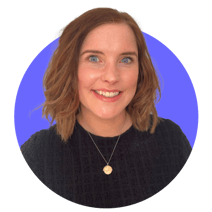
Fran Langham, Global Head of Demand Gen at Cognism, said:
“It makes more sense to focus on the ‘who’ rather than the ‘how many’.”
“Nine times out of ten, you might get 1,000 eBook downloads, but because you’re making the targeting and messaging so broad to reach as many people as possible - you’re actually shooting yourself in the foot.”
“When you dig into who those 1,000 people are, a huge proportion of them might not be who you’re looking to attract.”
Whereas if you were to optimise for bringing in a specific persona, your messaging can get much more specific and tailored, offering more value and ultimately attracting the attention of the people you want to bring into your orbit.
eBook formats - PDF or not PDF?
PDFs are pretty limiting when it comes to what you can include and embed in them. And realistically, what’s the appeal in having them be downloadable, anyway - so they can sit going stale on someone’s desktop?
Here are some alternative formats you could use:
- Digital magazines.
- Gated or ungated webpages.
- Flipbooks.
- Audio eBooks.
- Video guide.
Consider this. People are happy reading blogs natively on your website, so why not create a more interactive format there?

Liam Bartholomew, VP of Marketing at Cognism, said:
“There are lots of formats that you can gate - if you’re committed to gating your eBook. You can gate a page on your website, hide it from search. Or you could also have it rank for SEO and collect leads that way.”
This opens up a lot more possibilities in terms of formats you can add in. Web pages will support video, audio bites, even games if you want. Plus, it’s much easier to track performance! Not to mention, it’s also updatable.
As long as you make them easy enough to navigate and consume - they likely won’t miss having an additional PDF clogging their hard drives.
Putting the reader first
Think for a second about how you like to consume content. And the journey you’d ideally take to find and engage with the information you need.
Is it really to download an eBook, providing your contact details - only to find it doesn’t really answer the question you were hoping to answer, then to be contacted by the sales team of this company that you had zero interest in buying from?
Instead, might you prefer to get a sneak peek into the content - see the value-packed insights you can expect, have a variety of formats - all in one convenient package? Followed up by a well-rounded, thought-through on-demand nurture or follow-up process?
Instead of doing activity that serves as a means to an end, put the person you want to engage (and ultimately impress) at the forefront of your decision-making.
So, what would your buyer persona want to engage with?
Tom said:
“At Juro, our buyer personas liked reading. They were lawyers and they tended to enjoy written content, especially if you can get authoritative brands involved.”
But not every buyer persona will be into written content. If you’re unsure what format your buyer persona prefers, why not ask?
Make your eBook content work harder
If we are going to commit to using eBooks, then let’s actually commit. We can do so much with this massive content asset - beyond gating it for leads.
For example, you could release your eBook chapters one at a time as you write them (what do you think we're doing right now?!).
Once one chapter is ready, then release it as a blog and start getting some engagement from your audience. This doesn’t stop you from releasing the eBook at a later date, but it means that you’re consistently delivering valuable content without 3-6 months of nothing or 3-6 months of you still pushing last year’s.
Then there’s the distribution plan; how can we push this beyond the usual ‘download this eBook’ ads?
Could this content be more beneficial in thought leadership, establishing your brand as a credible source of information and expertise, encouraging affinity and trust so that your ICP wants to come to you? Rather than stuck behind a gate that a much smaller percentage will ever see?
Could you ask external B2B influencers or brand champions to share with their network?
And finally, there are so many options for repurposing the content afterwards!
- Could you use the basis of the eBook to get one of your internal subject matter experts to record to post incrementally on social channels?
- Could you break it into small chunks to use as newsletter content?
- Could you get experts from the industry to join you for a podcast episode to discuss certain elements or chapters?
What content is ‘eBook worthy’?
Whether you’re planning on gating your eBook or not - but especially if you are - the content has to live up to or exceed your prospects’ expectations. Otherwise, they’re not likely to have a positive experience with your brand. Nor are they likely to be thrilled by the subsequent call from your sales team. Or maybe any follow-up from your company.
Which means making sure your content delivers value to the people you hope to attract.
Liam said:
“You can’t just be repurposing SEO blogs as eBooks if you’re gating content - and realistically even if you’re not - it becomes all about quality. You want someone to think, ‘oh, I really want to see this’.”
Fran added:
“You have to move away from just pushing your product. You can have a dotted line back into your product, but your eBook should be about a wider issue they’re facing. This isn’t an opportunity to hammer people about your product.”
“If you want to talk about your product, you can put your eBook readers into a remarketing audience and then drip feed them content about your product there.”
eBook content rules
Want to make sure your eBook content stays high value? Stick to these rules:
1. It must either help inform your ICP about something they wish to learn or help them solve a real problem they’re facing
- Would they find the subject interesting? Enough to take time out of their busy work day to read?
- Is this based on research you’ve done or grounded by evidence from your ICP? For example, customer/ICP interviews or surveys.
- Don’t force content just because it aligns with your product. The primary goal is to engage and educate. Become a recognisable, credible source of information. The secondary goal would be a dotted line into your product.
2. It must be accurate and should include subject matter experts
- Have you worked with experts who can add credibility to the information?
- Could you have the content proofread by an expert who can sign off on it?
3. It must be unique
- While desk research can complement your eBook, if it’s just a compilation of information that can be found online, it’s not going to make for an impressive asset.
- Could you find it elsewhere online with a few Google searches?
- Does it contain images, graphs, and examples created specifically for this project?
Liam said:
“The easiest way to make your eBook unique is to work with subject matter experts (SMEs).”
To maximise eBook success, it’s far better to spend the necessary time and effort to produce something truly valuable for the intended audience. Which might mean producing fewer eBooks throughout the year.
Liam added:
“eBooks can’t be your only activity. If you’re doing them well, then they take some time. And that means you have to have other activities running alongside.”
Some of that time you might have spent working on your next big eBook release could now go towards properly analysing the success of the previous. Learning from what happened last time will better inform your next project.
Liam said:
“Plus, if you’re doing less of them, but the ones you produce are always really high quality, it’s much easier to get a buzz going around them. They can become highly anticipated.”
“Don’t just produce an eBook for the sake of producing an eBook. You should produce an eBook because it’s the best format for what you’re trying to achieve.”
Planning your eBook
Okay, so you know what you want to do; you’ve decided on a content format and a topic to write your eBook about.
But to get the best out of your eBook, you have some things to get in place.
Liam said:
“eBooks need to be better planned than they have been traditionally. You need to have all of your SMEs booked and ready to go. You need to know exactly what formats you’ll be using so that your SMEs can contribute to them.”
Here’s a list of some things you need to have in place before you get started:
Subject matter experts
- Who is best to speak to the subjects within your eBook? Are they internal or external?
- Are they a well-known SME in the space? Would your ICP recognise them?
- Have you contacted them to find out if they’d be open to working with you, and in what capacity?
- What exactly do you need from them? Have you given them a clear brief?
Resources
- If you’re going to test a new format, who do you need to involve from the team? E.g. web developer, videographer, content proofreader etc.
- Has everyone got a detailed brief of what their parts require?
- Have you secured budget?
- Have you planned what you need in terms of equipment - do you need microphones, cameras, or editing equipment.
Formats
- Are you using video or voice notes? If so, who’s recording them? And about what sections?
- Are you creating new content, not just an amalgamation of other content you’re repurposing?
- Are you using independent studies or research? Who’s conducting the research? How do you make sure it’s accurate, interesting and relevant?
Distribution
- If you’re doing a research study or report, are you going to send it to a PR agency or independent media company to report on?
- Are there any other third parties you need to involve in distribution? For example B2B influencers?
- Which channels are you sharing your eBook promotions on?
- What is the intended journey for the reader?
Deciding how much to gate
At this stage, when you’re about ready to start writing your eBook, it would be a good time to figure out your game plan for gating content. Because you have a few options.
Let’s first look at your options if you do need to collect leads for your sales team:

And then what about if you aren’t focused on lead generation?
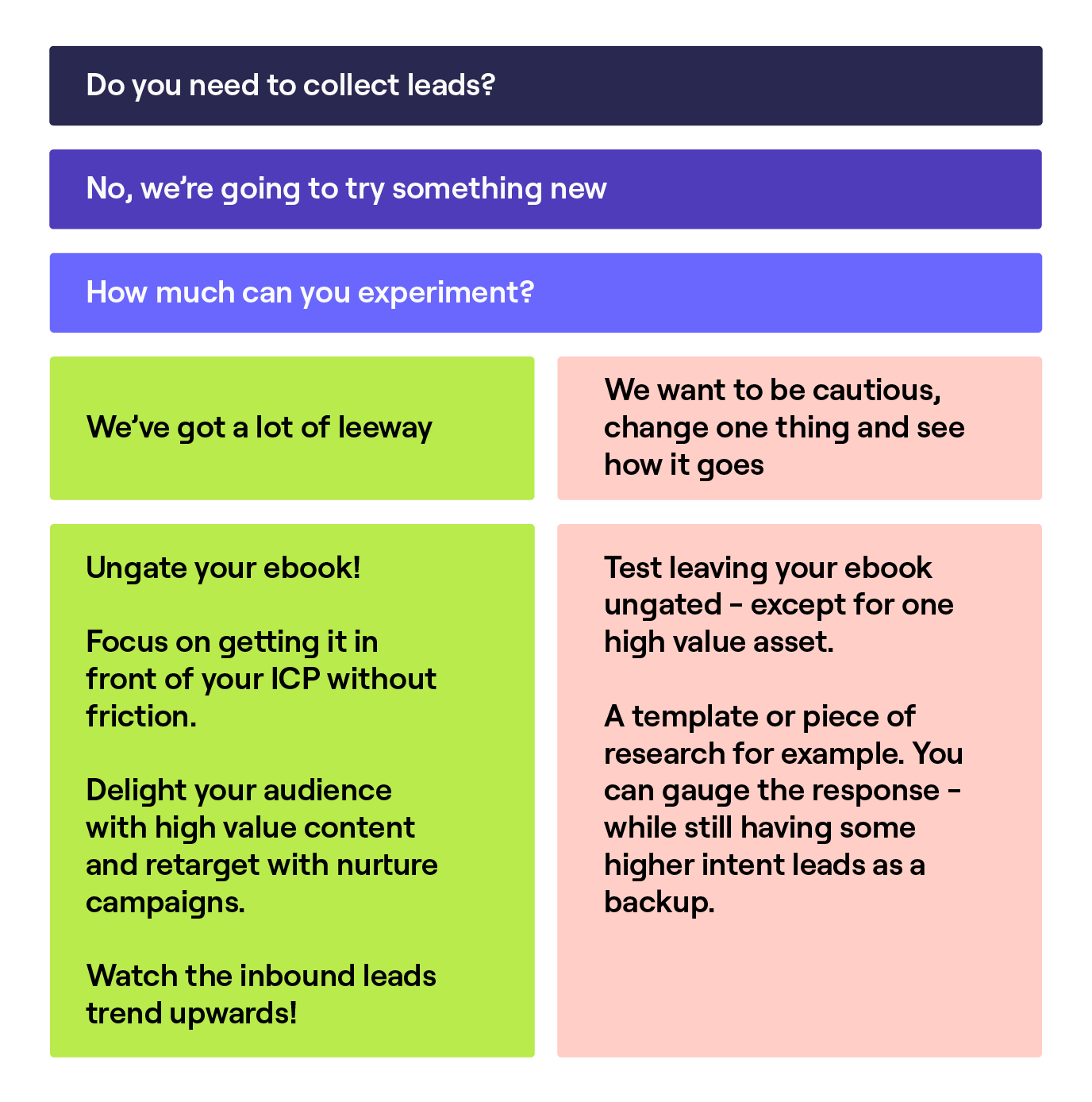
Liam threw another idea into the ring:
“You could have your eBook as a series. Give away the first one ungated, but get them to sign up for alerts for the next in the series when it comes out.”
Ultimately, it comes down to what you’re trying to achieve with your eBook. Is it establishing yourself as a thought leader with credible content? Or is it to hand over names and contact details to sales?
Either way, you want to prioritise getting the right people into your orbit. And delight them once they are.
Tom said:
“If you’re gating your eBook, you need to ensure that what comes after the gate is good enough.”
Otherwise, your efforts are likely wasted on a disappointed first impression of your brand, suggesting your services would likely not deliver on their promises either.
Tom added:
“And if you’re making a change, hold your nerve. Whenever you choose to stop doing something, it’s going to fall off a cliff. Things take time. But the results should be worth it.”
Chapter 2: Creating your eBook content
This is the fun bit - putting your eBook planning into action and seeing all the moving parts slowly coming together.
This is when you can make the biggest impact, making your content into something worth downloading.
Whether it’s the value-packed eBook content itself or the added extras you include to give it that special edge.
One thing to highlight before we get stuck into creating your content is:
You don’t just want to make your eBook something that looks good from the outside just to get people to download it.
You want people to actually read and engage with your content.
You want them to get genuine value. Learn from you. And start to perceive you as a thought leader. A credible source of information. A trusted brand. Learn about how you can solve problems for your ICP.
That should be your primary objective.
Because, if and when your prospect decides to come in-market for a product like yours, they’re far more likely to remember your business if they were impressed by their initial experiences with you.
Exclusive content
You could argue that your entire eBook content is exclusive if you’ve produced unique, value-led content behind a gate… but we want more!
If you want to make your reader feel like they’re getting bang for their buck (or contact detail exchange if that’s what you’re going for), then add in some extras, such as:
- Exclusive SME content - voice notes, tutorials, explainer videos.
- Templates - for example, how to calculate your x, y and z. Or a checklist for a, b and c.
- Exclusive podcast episodes.
- Swipe files.
They will make your readers feel like the download or engagement with your eBook was worth their time.
Plus, they’re more likely to actually read it!
Publishing chapters as you go
Now, you might think that this next recommendation goes against the previous advice, but let us explain.
Once one chapter of your eBook is ready, release it as a blog. This means you can start getting some engagement and feedback from your audience.
This allows you to edit and add to your eBook, based on the questions and qualitative feedback you receive (only making your eBook chapters better!).
And it doesn’t stop you from releasing the eBook at a later date - because your distribution campaign will likely push the full eBook to new audiences that haven’t seen the chapters on your website.
(As much as we’d like to believe that everyone has seen our website content, they probably haven’t…)
And the eBook’s value remains as a full breakdown or guide to the issue you’re trying to solve, with the added value of your exclusive content.
A collection of SEO blogs turned into an eBook isn’t the same as a specifically crafted eBook filled with SME insights that is then broken down into shorter articles you can publish along the way.
And it doesn’t have to just be blog content; you could also:
- Convert into a YouTube series, releasing explainer videos for each chapter.
- Record podcast episodes on each chapter, sharing them as you go.
- Use interviews with SMEs - snippet them up and use them for paid.
This way, you are consistently delivering valuable content without three to six months of nothing. Or three to six months of you still pushing last year’s eBook. Win-win!
For example, we recorded this podcast episode with Tom! Take a listen here:
Interactive content
How can you transform a lifeless bundle of text into something much more exciting and engaging? By making the content more interactive!
Here are some examples of how you could do that:
- Moving images, GIFs and animations.
- Polls.
- Videos - either informative or entertaining skits.
- 3D tours.
- Swipeable title pages with drop downs to read the content.
- Flippable pages.
- Icons that flip to reveal more information when you hover over them.
And if you’re unsure how, some of these companies offer some cool features, allowing you to pump some creativity into your eBooks.
Turtl
Turtl is a software platform that helps you to create, personalise, publish and track digital documents – with no need for specialist design or coding skills.
Businesses of all sizes use Turtl to create better marketing collateral, eBooks, white papers, newsletters, sales proposals and more.
Ceros
Ceros provides tools and services that empower companies to create interactive content with unparalleled ease and efficiency, driving customer engagement to new levels.
Webflow
Build with the power of code — without writing any! Webflow generates clean, semantic code that’s ready to publish or hand to developers.
Utilising SME insights
We’ve talked a lot about how you should work closely with subject matter experts throughout this process. But we aren’t the only ones advising you to use credible sources!
Tom said:
“The marketer writing the eBook likely isn’t the intended audience. They’re also likely not an expert on the subject.”
“You might have someone in-house who is, depending on who you’re targeting. But unless they’re an expert in the exact thing you’re trying to write about, then you should borrow some expertise.”
And that’s for multiple reasons:
SMEs can add another perspective
- The internal team are likely looking at the subject from their cultural and situational standpoint. An SME might be able to bring another side, point of view or opinion to enhance the content.
- SMEs can also be a little more opinionated or radical in their views as an individual rather than as a brand. They can say things that, as a brand, you may believe to be true but don’t feel you can say as a business.
SMEs are usually experts because they’re doing the role or have experience in the industry you’re talking about
- As marketers, we’re trying to position products and services to others - but unless you’re marketing to marketers, they’re probably in another role and industry to you.
- SMEs actively participate in the ins and outs of industry activity, facing pain points, speaking to colleagues and more. They can keep you up to date with trends and news.
They can help you make the content unique, credible and interesting
- By asking your SME to speak to the subject you’re creating your eBook about, they can give you some unique insights that people can’t find in a Google search.
- Provided your chosen SME is recognisable, they’ll likely attract readers as people are interested in finding out what they have to say.
- Readers are also more likely to see your content as trustworthy as they already trust the SME’s voice and opinion.
They can take some of the workload off you
- SMEs, especially when they create content on their own channels, can help with content creation for your content.
- Depending on your working relationship with the SME, you could hand over sections for them to produce or ask them to create additional resources to go alongside.
So, how can you work with SMEs?
Again, you have some options!
- Interview them on subjects you’ll cover in your eBook and weave their quotes into your content.
- Alternatively, you could have their ‘hot takes’ at the end of each section.
- Ask them to film short sections to include; these will break up the text and provide content in a format that people prefer to consume.
- This could include short tutorials, tips, opinion segments or informational add-ons.
- Ask them to record voice notes, which you can embed in the eBook.
- This could be as simple as their take on the topic you cover in that eBook section.
- Get them involved in the promotion and distribution!
- Whether it’s talking about their involvement in the content creation or sharing links with their network, utilise their reach.
How we work with SMEs and B2B influencers
Who is the right SME to work with?
There’s a fair amount to consider before choosing your subject matter expert. Not only do they need to be a recognisable expert in the field, but they also need to reflect your intended readers.
Do they work for a similar company to your target readers? In terms of company size, industry, stage of growth, and mindset?
Can they suggest examples or offer advice that makes sense for your target persona?
Tom said:
“Once you have one person on board, you can ask them if they know anyone else in the space who would be good to talk to about the specific subject.”
After all, they’re likely to know others working in the same industry who may have another perspective or expertise.
Tom added:
“Niche is always better. Someone with a unique viewpoint.”
“You want the combined insights from your contributors to be greater than the sum of its parts.”
In other words, get multiple contributors who can tell a compelling story to your audience.
Tom’s last piece of advice when working with SMEs is an important one:
“It’s not all about take.”
“This SME has likely worked years to be in a position to be an expert on this subject, and they’re lending their professional authority to you. That’s a nice thing for them to do. So do something nice back.”
“Send them a gift or something. You never know when you might need this person’s help again."
Chapter 3: Promoting your eBook
At this stage in the process, you should be excited about the high-value asset you’ve created and encouraged to get it spread as far and wide as possible.
The important part at this stage is to lean into what you already know about your customers.
Fran said:
“If you know your customers spend a lot of time on Facebook, then make sure your eBook is all over Facebook.”
“If you know that a lot of your customers listen to your podcast, then why not repurpose your eBook into podcast episodes so that they’re more likely to engage and get value from the content.”
And on that note, thinking about your intended audience shouldn’t stop there…
Why you should create a value-led journey
We all know by now that the buyer journey isn’t linear. We as marketers can’t force buyers who aren’t in-market, to come in-market before they’re ready.
And if we try to, we’re more likely to have the opposite effect and send them into the arms of our competitors due to pushy, unpopular tactics.
So the idea is to do what we can to build positive associations with our potential prospects by sharing content they want to engage with as often as possible. Remaining front of mind, and hopefully viewed as a trusted, credible organisation.
So that when they decide they’re ready to buy, they come to us.
And we can apply that mindset shift to our eBook experience.
Putting the user experience over any agenda to push leads. Giving those experiencing our brand for the first time an overwhelmingly positive interaction - and reinforcing for those who already know us that we’re worth keeping in mind.
Think about what the user expects to happen at each stage, and then what you can do to delight them. How can you exceed their expectations?
For example, when they’re engaging with your eBook, why not use a personalised popup or chatbot to ask them about which pain point is most relevant to them? Use that to direct the content you send to them next.
The main point we urge you to remember is to resist getting people into a funnel and asking for a demo.
Because put simply, it isn’t what the reader wants or what they’ll find valuable at this stage.
Instead, create alternative pathways to continue engaging with your brand until they either feel the need to come inbound to you - or give you a better indication of intent.
How we do this at Cognism is through our value loops.
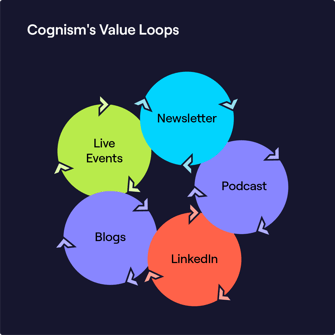
Value loops are anywhere your audience can subscribe, follow or attend regularly to get repeatable value. This can be your:
- Organic social channels.
- Podcasts.
- Blog.
- Live events.
- Newsletters.
- YouTube channel.
- And more.
The important part of this is to be everywhere our ICP hangs out, delivering highly relevant content consistently over time. Increasing the numbers of your ICP engaging on those channels.
It’s all about being memorable. There’s a lot of noise out there - one-off actions aren’t likely to be remembered, so doubling down on subscription-based channels such as podcasts, YouTube or newsletters means you can build an engaged audience and focus on the quality of the content.
If you build out your audience, then you can make data-driven decisions based on the types of companies and job titles that are engaging with your content.
Asking yourself questions like ‘does this fit with our ICP? And in turn, is this helping us to build the right pipeline for our business?’
The feedback loop is very important! Listen closely to signals and feedback from your ICP to ensure content is resonating on the channel.
Distributing your eBook
It’s all well and good having this amazing value-led asset - but if you don’t know how to get it out into the world, then no one will ever see it.
Getting a comprehensive distribution plan in place to maximise the reach of your content can make all the difference in an eBook campaign.
There are so many options for where to distribute your eBook (especially if you choose to have it ungated!). For example:
Using your SMEs
If you chose your SME well, they should already have a following of your ICP, making them a goldmine to tap into. Ask them to share your eBook with their audience.
- For example, when we launched Alice’s Diary of a First Time CMO, we worked with 8-10 subject matter experts who shared the content with their network which supercharged the campaign. It was everywhere on LinkedIn on launch day!
- Get SMEs to re-record insights to camera to highlight some of the key takeaways in the eBook for use on organic or paid social.
- Online event with your SMEs answering questions based on topics in the eBook.
Create a scarcity-driven offer to launch the eBook with.
The aim is to get dark social talking and spread the word, getting a buzz going around a great offer and the book. If it feels like there’s a limited number who get access, everyone will be fighting to download!
Book launch event
Alex Hormozi launched his book during a virtual event where attendees (and only attendees!) would receive additional resources. Check out his promotional video for his book launch event here!
- What made his launch so successful?
- Incentivised word-of-mouth referrals (top sharers get an invite to a private event plus exclusive content).
- Giveaways - those who attended his live event got access to a project ‘he had been working on for four years’.
- Social proof from audience numbers - e.g. ‘208,000 people have registered’.
Create an owned audience
- You don’t need to rely on third-party companies or content syndication (paying another company to gate content and send you leads).
- Could be your own app if you have one - or a Slack community if not. Share exclusive content, hold exclusive events, and provide high-value insights specific to the persona.
- An owned audience is the best and quickest way to get feedback. Ask audience members to share reviews or what they didn't like so you can improve next time.
Tom said:
“We now have a private group of over a thousand. We do private events and content with them every week - and we’ve found these members close at double the rate that non-members do. It just turbo-charged our nurture.”
Sanaa Siddiqui, Content Editor at Juro said:

“Community plays a huge part in our eBook distribution. We have built a community of our ideal customers, so I try to get as many of those eyes on our content as possible.”
“Creating an owned audience has worked really well for us. Our weekly community newsletter, for example, has an average open rate of 50%, and an average clickthrough rate of 20%.”
Paid social
This one is likely already in your distribution arsenal but there are some things you could do to shake things up and stand out from the usual eBook ads.
- Get your SME involved in some videos to promote the eBook on paid channels.
- Re-use customer reviews - post screenshots as ads on social.
- Utilise new ad formats to get a reasonable cost per reach - e.g. document ads are a good shout for eBooks.
- Snippets of podcast interviews with the SME on a chosen topic that can link to the eBook.
Newsletters
- Include a soft CTA to your eBook in your newsletter.
- Use short sections and insights from your eBook to tease the content in your newsletter.
Repurposing your content into other things to feed your media machine
- YouTube series.
- Podcast series.
- Bite-sized blog posts.
Give customers, advocates or champions access to the eBook to share and recommend to their network
- If they’re already customers - they likely have other people in their network who are in similar businesses or industries.
- Incentivise them to share! Offer free credits to your platform or enter into a prize draw for a reward.
Chapter 4: Post-download nurtures
We’re drawing a line in the sand - there’s really no benefit to making premature sales calls to prospects whose only interaction with your brand is an eBook download.
The intent level shown is almost nothing and you’re more likely to aggravate your ICP versus delight them.
Diego Oquendo, Marketing Manager at Catalyst Consulting, said:

“Lead gen might be an easy way to get more MQLs (contacts) through the door to try and meet sales quarterly targets.”
“But for example, if your sales cycle is in 6 months and you have 2 weeks left of the quarter… Your sales team might rely too heavily on contacts from lead gen forms who have little or no intent.”
“Which may ultimately get annoyed with your company and harm your brand’s reputation in the long run. This is one of the problems with lead gen.”
Is there a better way?
Give them things they want.
- Find out the problems they need to solve and offer them content to help.
- Share entertaining videos that they enjoy engaging with.
- Put on exclusive events for those in your nurture bucket.
Alice de Courcy, Cognism CMO, said:
.png?width=213&height=213&name=Alice_de_Courcy-removebg-2b%20(1).png)
“A lot of us marketers put all of our focus on the conversion - getting people to download the eBook. Ad copy, landing page copy, how much you give upfront versus how much you gate…”
“And often, the thought ends there.”
“Your reader fills in the form, goes to a classic thank you page and then you’re in a standard nurture sequence from marketing and outbound.”
“But how do we make sure that the person who downloaded the eBook actually reads it - because ultimately, your goal should be engagement.”
“You need to find interesting ways to remind them about the content - and not worry about converting to a meeting at this point.”
“And following up with other relevant content over time.”
“Ultimately, it just increases the chances that when sales do reach out, they remember your company, which will make that sales conversation so much easier.”
So what might your post-download nurture look like?
No matter what direction you choose for your nurture campaign, it has to put the downloader first. You can’t guarantee that they’re in a buying phase or force them to take action before they’re ready.
So it makes much more sense to delight them with unexpected extras, going the extra mile to add value so that they have the best possible experience of your brand.
After all, it’s called a nurture campaign for a reason!
Fran said:
“You could send your list of contacts who downloaded your eBook an invite to an exclusive event with the SMEs featured in the content. Whether it’s a presentation going into more details or a Q&A where readers can ask questions about the eBook topic.”
What do we mean by an on-demand nurture?
Nurtures on demand are entire email nurture sequences that you host on your website. This means the prospect can access the entire nurture at once, rather than waiting for your drip emails to arrive in their inbox.
Sounds like a blog page, right?
It’s not. Nurture campaigns, when done right, tell a story. They take the reader through a well-designed journey. Providing the perfect content to fill knowledge gaps and share information about your product.
Here’s an example of an on-demand email nurture we use!
How to equip your sales team for post-content download sales conversations
One of the areas of contention around gated eBooks comes down to the lack of communication between sales and marketing during the handoff process.
Marketing can’t expect sales to have efficient conversations with prospects post-download if they haven’t got a clue what the eBook was about - or what the likelihood of the prospect having read the eBook is.
And sales can’t expect marketing to read minds - if the quality of the leads coming through the pipeline from content downloads is bad, then there needs to be a productive conversation about improving them.
Alice said:
“Being realistic, your sales team is not going to read your eBook.”
"And depending on who you’re selling to - for example, selling to senior lawyers - the knowledge gap between the content in the eBook and the salesperson in the next step is large.”
“There needs to be some level of understanding of the content if there’s to be any chance of getting a meeting booked. This is why marketing needs to invest time with the sales org to enable them.”
So how can marketing and sales get on the same page regarding how to follow up with eBook downloaders?
Tom said:
“Your prospects might not be ready to buy right now, but the sales team needs to have a process for where to go from there.”
In other words:
- What’s the long-term play?
- How do we keep this prospect in our orbit until they’re ready to buy?
- If they’re not ready to buy now, how can we stay in touch?
- And how can we incentivise or educate the sales team on the benefits of a long-term relationship with prospects?
Tom added:
“If the feedback to your sales team is ‘We read your eBook and we loved it’ then that’s great. Because what they’re actually saying is we like your brand.”
Chapter 5: Measuring the success of your eBook
If all goes well in the previous four chapters of this eBook, then you should be thrilled to reach this stage. Because now you get to see the fruits of your labour.
Depending on what route you took to get here, you might be measuring slightly different things. Ultimately, it depends on what you hope to achieve with your eBook. Is it to gather as many leads as possible? Or is it a demand generation play?
Measuring gated vs. ungated eBooks
If you have your entire eBook gated, then you’re likely looking at just the number of leads you’ve been able to generate. And hopefully, assessing their quality before you pass them onto sales.
If you ungated your entire eBook, then you’ll likely be looking holistically at the engagement in the content. For example:
- Impressions, reach, video views, frequency.
- CTR, engagement rate, likes, comments.
- Qualitative feedback/shares.
- Traffic, time on page, bounce rate.
Sanaa said:
“For us, eBooks have transformed from lead magnets to effective assets for nurturing our ideal customers.”
“Instead of measuring SQLs, I focus more on download rates, click rates, and engagement - particularly on LinkedIn, where our audience is most active.”
“It’s definitely a sign of success if contributors are eager to share their work - it elevates our brand, and helps us identify as an authority on in-house legal, and more specifically, all things contracts.”
Top tips for reporting on eBooks
Before you start measuring the success of your eBook you need to be aligned on the core goal you’re trying to achieve:
- Some companies may be targeted on the number of leads and/or the quality of those leads.
- Here at Cognism, our primary goal would be to provide value-driven content to our core ICP.
You also need to set out with a number of objectives that feedback into your core goal and measure those activities in a realistic way.
For example, why would we measure a campaign on click-through rate when we were optimising for reach?
Why measure a video series on conversions when what we are really looking for is engagement and infeed consumption?
Leading indicators
Regardless of whether you decided to gate your ebook and collect leads or un-gate and go for maximum value, your first focus should be the leading indicators:
- Is the content resonating?
- What qualitative feedback have you received?
- How does the engagement on paid social look?
- If you have distributed on multiple channels and in multiple formats (which we strongly advise you do) which channel and format is performing best?
A core goal for us at Cognism, when creating content like eBooks, is to create value-led journeys so we encourage our audience to sign up for our value loops e.g. podcasts.
If your reader has gained genuine value from your eBook and wants to see more from your organisation - they’ll likely jump at one of the CTAs to follow your content online.
If you see those audiences growing, and especially if you can see that the people joining are from your ICP, then you know your marketing strategy is working.
Fran said:
“Look at all the channels you have distributed this eBook on.”
“Who is actually reading this content and are they in your core ICP? Look at job titles, company size, interactions on certain topics.”
“Deep dive platform demographics - we’ve served 51k impressions but who is actually interacting? Is it our desired audience? Is our content resonating?”
So now you have a really good picture of the overall value you’re providing and to whom.
You can also deep dive into which parts of the eBook resonate the most and double down on topics related to them!
Lagging indicators
Depending on your objective, the next step is to look at the lagging indicators.
Fran said:
“For us at Cognism we’d look at the growth in inbound demo requests and look at the last touch channel as an indicator of what is driving these.”
“However, as mentioned the buyer journey isn’t linear, nor can we track every single interaction so if last touch was an eBook we would see this as an influence, not a direct attribution or single source of truth.”
Extra reporting options
Human attribution
- The ‘how did you hear about us’ question.’
- It’s a great way to uncover insights that you otherwise might not have been able to see, such as dark social recommendations.
Heat maps
- As we discussed early on in this eBook, reporting on the success of your content is much easier when you’ve got more control over the platform.
- There’s not much you can see beyond how many people downloaded your PDF.
- But if you host your eBook on your website, you can apply heat maps to see how people interact with your content. The chapters they revisited. Or where the audience tends to drop off.
- This gives you much more insight into how you can iterate and update the page over time - rather than leaving it as a set-and-forget exercise.
UTMs
- Using UTMs can also help to measure the impact, putting equal weight on first touch versus last touch - given that we know buyers will bring themselves in-market when they are ready to buy.
Fran said:
“In short you need to measure everything, or as much as you can.”
“A big mistake marketers often make is introducing bias by ignoring channels that aren’t easy to measure!”
“Of course not every single interaction can be tracked but don’t ignore patterns and journeys that don’t fit into the neat little box that we are all familiar with:”
❌ Clicks email >> downloads eBook >> in pipe because ready to buy ❌
The feedback loop
While it’s tempting to get caught up in the numbers and leads, it’s important not to forget about qualitative feedback.
Especially if you’re using a PDF format, how else would you get an idea of how many people are reading the content versus just downloading and letting it die on their hard drive?
Liam said:
“You might have a whole lot of downloads, but no one actually reads it because the format is really difficult to get into - or the content doesn’t answer the question they were looking for.”
So, giving your audience a chance to feedback about the content simply gives you a better picture of how the content is being engaged with - ultimately allowing you to create even better content next time.
You should also pay close attention to the feedback loop coming from not only your own audience but the feedback your SME receives.
Some readers may wish to go straight to the source rather than reaching out to a company - so ask your SMEs to get involved in the feedback process.
How to report back up to leadership
If you’re moving from a lead gen approach to eBooks into utilising more demand gen principles, then it’s important to manage expectations when it comes to reporting.
There will be a transition period when you move from reporting on MQLs to less concrete metrics. But that’s because the goal changes. From low-quality contacts to engagement from your ICP.
And that’s how it needs to be positioned to senior leadership. The metrics have changed because they need to change in order to reach this new goal.
|
Old way |
The ultimate goal of demand is: |
|
Total # of leads generated |
Inbound demand |
|
Cost-per-lead |
Pipeline |
|
Revenue |
You’ll need to demonstrate that your demand gen activities are impacting those figures. Which is much more difficult but 100% possible.
There is no one report that will tell you everything. The truth is - you need to measure everything. And use that data to identify signals and trends that show your efforts are working.
There are two main areas you want to measure, with equal weight.
- Reach and engagement.
- Conversion.
Blending these two will be how you demonstrate your efforts are working.
eBook marketing: The last word
Hopefully, this ultimate eBook on how to do eBooks has helped you visualise where this activity can fit into your future marketing strategies. Better serving the modern buyer and establishing your business as a credible thought leader.
